The Realities and Potentials of AI-Generated Content
Ever wondered why your AI-generated content doesn’t quite hit the mark? Maybe it’s not the technology at fault, but our expectations. While we dream of creating Shakespearean prose at the click of a button, AI is more of a plucky, eager intern than a literary genius. The ai generated content examples discussed in recent analyses offer some intriguing insights into this dynamic.
Understanding the Intern: AI’s Current Capabilities
AI-generated content is, at its core, a reflection of the data it’s trained on. Imagine an intern fresh out of college. They know the theory, they’ve read the books, but they lack the nuance that comes from experience. Similarly, AI can regurgitate information in coherent sentences, but it often misses the subtlety and depth that human writers bring. Despite this, AI-generated content is not without its transformative potential.
The Transformative Potential of AI Content
Why bother with AI content, you ask? Because it’s like having an intern with unlimited stamina. Need a blog post drafted at 3 AM? AI’s got you. The potential lies in its ability to handle vast amounts of data and generate content at a speed and scale unimaginable for humans. It’s not about replacing human creativity but augmenting it. When human oversight is paired with AI’s capabilities, content creation becomes a collaborative effort, leading to new and unexpected outcomes.
Challenges in AI Content Creation
Yet, let’s not put our intern on a pedestal just yet. AI-generated content can sometimes lack accuracy, creativity, and emotional resonance. The uncanny valley of language, if you will. It’s prone to hallucinations, those moments when AI confidently asserts something entirely false. This is where human editors come in, adding the layer of judgment and intuition that AI currently lacks.
Making the Most of AI-Generated Content
So, how do we harness the power of this tireless intern effectively? Here are a few actionable steps:
- Train Your AI Intern: Customize and fine-tune AI models with industry-specific data for more relevant content.
- Collaborate, Don’t Delegate: Use AI for initial drafts and let humans add the finishing touches.
- Quality Control: Implement rigorous editorial processes to ensure the accuracy and quality of content.
- Embrace the Unexpected: Allow AI to explore creative angles you might not consider, but always review the output critically.
In conclusion, AI in content creation isn’t about replacing the writer; it’s about empowering them. By understanding its current limitations and embracing its potential, we can transform content creation into a symbiotic relationship between human and machine. Let’s guide our AI intern wisely, and perhaps, it will surprise us with its potential. For more insights into the possibilities, you can visit Page 2 of archetypesoftware.
Checkout ProductScope AI’s Studio (and get 200 free studio credits)

